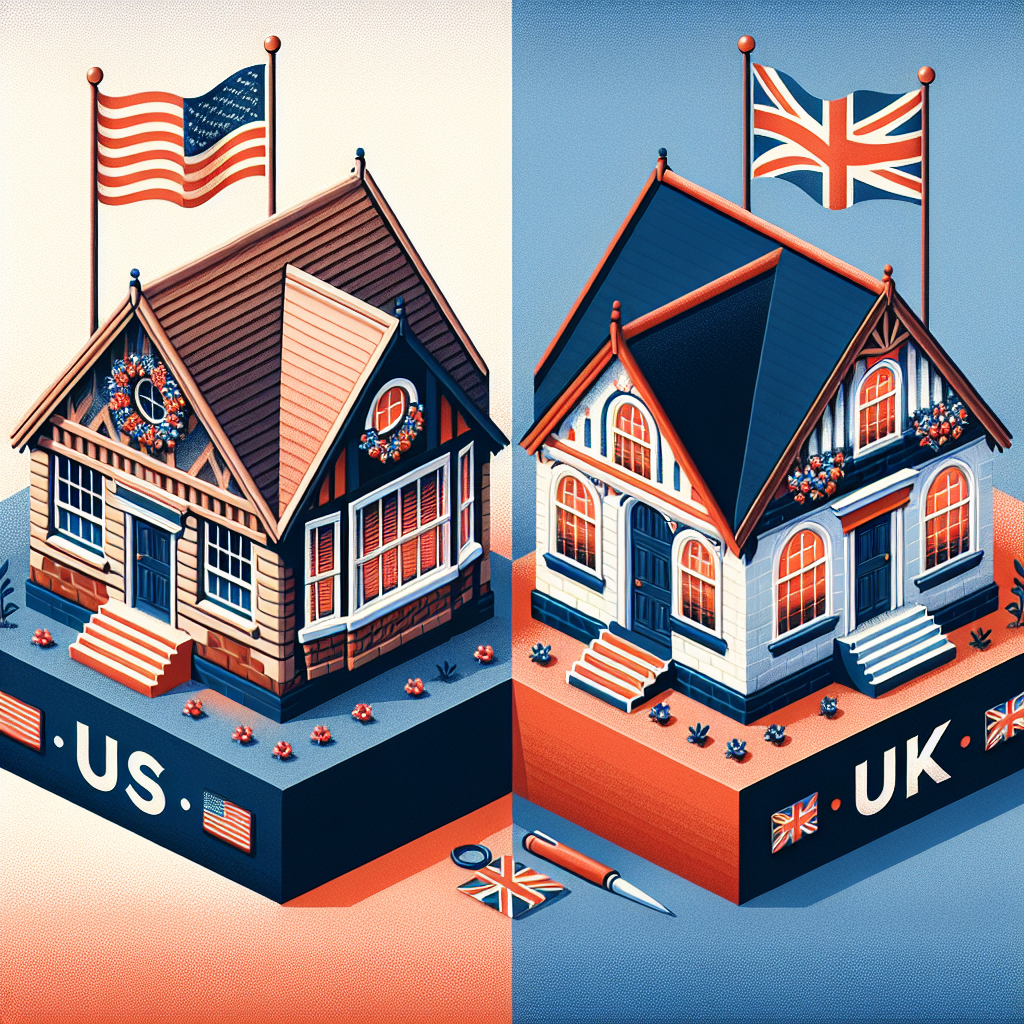Are you curious about the contrasting aspects of mortgages in the United States and the United Kingdom? Understanding the distinctions between these two countries’ mortgage systems is crucial when considering investing in real estate. From interest rates to repayment schedules, this article will provide you with a concise overview of the key differences between US and UK mortgages. Whether you are a prospective homeowner or an investor, delving into this topic will equip you with valuable knowledge for making informed choices in the property market.

Overview of US and UK Mortgages
Basic Definition of a Mortgage
A mortgage is a loan that is used to purchase a property, such as a house or commercial building. It is a legal agreement between the borrower and the lender, where the borrower agrees to make regular payments over a specified period of time to repay the loan amount plus interest. In both the US and the UK, mortgages are long-term loans that require collateral, which is usually the property being purchased.
Importance of Mortgages in US and UK
Mortgages play a crucial role in the housing markets of both the US and the UK. They make it possible for individuals and businesses to afford the purchase of property by spreading the cost over a longer period of time. Mortgages also stimulate economic activity by promoting construction and real estate development, as well as providing financial stability to homeowners and investors. Furthermore, the availability and affordability of mortgages can impact the overall health of the housing market and the economy as a whole.
Property Types and Loan Purposes
Residential Properties
Residential properties refer to homes that are used as primary residences, secondary homes, or rental properties. In the US and the UK, mortgages are commonly obtained to finance the purchase of residential properties. These can include single-family houses, condominiums, townhouses, and apartments. The loan amount and terms may vary depending on factors such as the borrower’s income, creditworthiness, and the location and value of the property.
Commercial Properties
Commercial properties, on the other hand, are buildings or land that are used for business purposes. This can include office buildings, retail spaces, warehouses, and industrial facilities. Mortgages for commercial properties differ from residential mortgages, as they typically involve higher loan amounts and different underwriting criteria. In the US and the UK, commercial mortgages are often used by businesses to acquire, develop, or refinance properties for their operations.
Loan Purposes
In addition to financing the purchase of properties, mortgages can also be used for other purposes. These can include refinancing existing loans to secure better interest rates or loan terms, home equity loans and lines of credit to tap into the value of the property, and construction loans for building new homes or commercial buildings. The purpose of the loan can affect the terms and conditions offered by lenders in both the US and the UK.
Mortgage Terminology
Mortgage Term
The mortgage term refers to the duration of the loan. In the US, mortgage terms typically range from 15 to 30 years, with some lenders offering shorter or longer terms. In the UK, mortgage terms usually range from 25 to 35 years. The length of the mortgage term affects the monthly payments and the total amount of interest paid over the life of the loan.
Interest Rates
Interest rates are a crucial component of mortgages. They determine the cost of borrowing and can vary depending on factors such as the borrower’s creditworthiness, the type of mortgage, and market conditions. In the US, interest rates can be fixed or adjustable, with fixed rates remaining the same for the entire mortgage term and adjustable rates fluctuating over time. In the UK, interest rates can be fixed, variable, or tracker rates linked to the base rate set by the Bank of England.
Amortization
Amortization refers to the process of gradually paying off the mortgage loan through regular monthly payments. The payments typically consist of both principal and interest, with a larger portion of the payments going towards interest in the early years of the loan. Over time, more of the payments go towards reducing the principal balance. In both the US and the UK, most mortgages are amortizing loans, although interest-only mortgages are also available.
Prepayment Penalties
Prepayment penalties are fees charged by lenders if a borrower pays off their mortgage before the end of the loan term. In the US, prepayment penalties are not as common and are often prohibited for residential mortgages. However, in the UK, prepayment penalties may be charged, especially for fixed-rate mortgages. It is important for borrowers to be aware of any prepayment penalties before signing a mortgage agreement.
Loan Amount and Loan-to-Value Ratio
Maximum Loan Amount
The maximum loan amount is the highest amount that a lender is willing to lend to a borrower for a particular property. The loan amount can vary based on factors such as the borrower’s income, credit history, and the value of the property. In both the US and the UK, lenders have limits on the maximum loan amount they are willing to offer, which helps protect against excessive borrowing and potential loan defaults.
Loan-to-Value Ratio
The loan-to-value (LTV) ratio is the ratio of the loan amount to the appraised value or purchase price of the property, depending on which is lower. The LTV ratio is an important factor in determining the risk to the lender and affects the interest rates and terms offered to the borrower. In the US, higher LTV ratios generally require the borrower to obtain private mortgage insurance (PMI), while in the UK, mortgage indemnity guarantee (MIG) may be required for higher LTV ratios.
Minimum Down Payment
The down payment is the initial payment made by the borrower towards the purchase of the property. It is usually expressed as a percentage of the purchase price and represents the borrower’s equity in the property. In the US, down payment requirements can vary, but typically range from 3% to 20% of the purchase price. In the UK, the minimum down payment required is usually around 5% to 20% of the purchase price, depending on the lender and the borrower’s circumstances.

Mortgage Application Process
Mortgage Application Requirements
When applying for a mortgage, borrowers are required to provide certain documentation to support their application. This can include identification documents, proof of income, bank statements, and details of any existing debts or financial commitments. In both the US and the UK, lenders require borrowers to complete an application form and provide accurate and truthful information.
Credit Score Evaluation
Credit scores play a crucial role in mortgage applications. They assess the borrower’s creditworthiness and indicate the likelihood of them repaying the loan. In the US, the FICO credit scoring system is commonly used, while in the UK, credit reference agencies such as Experian, Equifax, and TransUnion provide credit scores. Higher credit scores generally result in better interest rates and loan terms, while lower scores may lead to higher interest rates or loan rejections.
Income Documentation
Borrowers are required to provide proof of their income to demonstrate their ability to afford the mortgage payments. This can include payslips, tax returns, and bank statements. In both the US and the UK, lenders evaluate the borrower’s income stability, employment history, and debt-to-income ratio to assess their ability to make timely mortgage payments.
Approval Process
Once the mortgage application is submitted, it goes through a review and approval process. Lenders evaluate the borrower’s creditworthiness, financial stability, and the property being financed. They may also order an appraisal to assess the property’s value. The approval process typically involves a detailed analysis of the borrower’s financial situation and may take several weeks to complete. If approved, the lender issues a formal loan offer, which can be accepted by the borrower.
Mortgage Rates and Fees
Interest Rate Options
Mortgage interest rates can be fixed or adjustable in both the US and the UK. Fixed rates remain the same for the entire mortgage term, providing stability and predictability in monthly payments. Adjustable rates, on the other hand, can fluctuate over time based on changes in market conditions. In the US, borrowers can choose from fixed-rate mortgages, adjustable-rate mortgages (ARMs), or hybrid mortgages that combine fixed and adjustable rates. In the UK, borrowers can select from fixed, variable, or tracker rates.
Mortgage Fees
Mortgages come with various fees that borrowers are responsible for paying. These can include application fees, appraisal fees, origination fees, closing costs, and legal fees. Mortgage fees can vary depending on the lender, the type of mortgage, and the location of the property. It is important for borrowers to carefully review and understand these fees as they can significantly impact the overall cost of the mortgage.
Comparison of US and UK Mortgage Rates
Mortgage rates in the US and the UK can differ due to various factors, including economic conditions, government policies, and lender practices. Interest rates generally have a direct relationship with the risk associated with lending, as well as global and local market influences. It is important for borrowers to compare mortgage rates from different lenders to ensure they are getting the most competitive rates available.

Mortgage Insurance
Private Mortgage Insurance (PMI)
In the US, private mortgage insurance (PMI) is often required for borrowers who have a loan-to-value (LTV) ratio higher than 80%. PMI protects the lender in case the borrower defaults on the loan. The cost of PMI is typically included in the monthly mortgage payments until the borrower reaches a certain level of equity in the property. Once the LTV ratio drops below 80%, borrowers can request the cancellation of PMI.
Mortgage Indemnity Guarantee (MIG)
In the UK, mortgage indemnity guarantee (MIG) is a type of insurance that may be required for borrowers with a higher LTV ratio. MIG protects the lender in case of default and is similar to PMI in the US. The cost of MIG is included in the mortgage interest rate or as a separate fee. Like PMI, MIG is typically required until the borrower reaches a certain level of equity in the property.
Government Support and Regulations
Government Backed Programs
Both the US and the UK have government-backed programs that aim to support homeownership and provide assistance to borrowers who may have difficulty obtaining traditional mortgages. In the US, programs such as the Federal Housing Administration (FHA) and Veterans Affairs (VA) loans offer favorable terms and lower down payment requirements to eligible borrowers. In the UK, the Help to Buy scheme provides government-backed loans and equity loans to help first-time buyers and home movers access the housing market.
Federal Housing Administration (FHA)
The Federal Housing Administration (FHA) is a US government agency that insures mortgages issued by approved lenders. FHA loans are designed to make homeownership more accessible, particularly for borrowers with lower credit scores or smaller down payments. FHA loans have specific requirements and guidelines, including limits on loan amounts and mandatory mortgage insurance.
Veterans Affairs (VA)
The Veterans Affairs (VA) loan program is available to eligible members of the military, veterans, and their surviving spouses. VA loans are guaranteed by the US Department of Veterans Affairs and offer benefits such as no down payment, competitive interest rates, and no mortgage insurance requirements. VA loans help make homeownership more attainable for those who have served or are currently serving in the military.
Help to Buy Scheme
In the UK, the Help to Buy scheme aims to assist first-time buyers and home movers who have a small deposit. The scheme provides government-backed loans and equity loans to help borrowers access the housing market. The loans can be used to purchase newly built homes or existing properties. The Help to Buy scheme offers different options tailored to the borrower’s needs and circumstances.

Foreclosure Process
Foreclosure Laws and Procedures
Foreclosure is the legal process by which a lender can take possession of a property when the borrower fails to make mortgage payments. The laws and procedures regarding foreclosure vary between the US and the UK. In the US, foreclosure laws are primarily governed by state laws, and the process can be judicial or non-judicial depending on the state. In the UK, the foreclosure process is referred to as repossession and is largely regulated by the courts.
Impact on Credit Score
Foreclosure or repossession can have a significant negative impact on a borrower’s credit score. A foreclosure or repossession is considered a major delinquency and can remain on a credit report for up to seven years in the US, making it difficult to obtain new credit or loans. In the UK, a repossession can also have a detrimental effect on a borrower’s credit history and future borrowing potential.
Tax Implications
Mortgage Interest Deduction
In the US, homeowners may be eligible to deduct the interest paid on their mortgage from their taxable income. This can result in tax savings, especially for borrowers with higher mortgage balances and interest payments. The mortgage interest deduction is subject to certain limitations and may require itemizing deductions on the borrower’s tax return.
Property Tax Deductions
Both the US and the UK allow homeowners to deduct property taxes paid on their primary residence from their taxable income. This can provide homeowners with a reduction in their overall tax liability. Property tax deductions vary depending on the jurisdiction and the value of the property.
In conclusion, while US and UK mortgages share some similarities in their basic definition and purpose, there are notable differences in terms of mortgage terminology, loan requirements, interest rates, government support, and tax implications. Understanding these differences is essential for borrowers seeking to navigate the mortgage process in either country. Whether you are considering purchasing a residential or commercial property, or exploring different loan options, it is important to research and consult with professionals to make informed decisions about your mortgage.


